
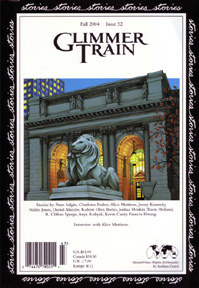 Glimmer Train, Volume
52
Glimmer Train, Volume
52
Theme: Mostly family-type stories, mainly
because they like stories that are "emotionally engaging."
Editor(s): Susan Burmeister & Linda B.
Swanson
Address: 1211 N.W. Glisan St., Suite 207
Portland, OR 97209
Website: www.glimmertrain.com
Glimmertrain is a literary journal that is
put together well and the photography within is submitted
from the author whether relevant to the story they submitted
or not.
The journal offers up small author bios with
each story but leaves the author space in the back to talk
about the process of the piece. Here, the author can again
submit a picture relevant to the story or their life.
Stories are well written by established writers.
The common theme would be of family and heritage (usually
a combo of both). There are distinct voices in many of the
stories. You can picture these people because of the description,
can see their ethnicity and hear their accents. the authors
know their characters very well. From the author's words,
research was done where applicable, places were visited
when needed and memories were evoked when appropriate. Whether
fiction or not, each author puts out there that even ficiton
has to start with a thought that may be half true, but somewhere,
there is an ounce of truth.
For the fiction writer who is ultimately putting
stories out based on their past history within the family,
whether it be the dynamics of or the history (ethnic or
emotional history), this would be the perfect fit. These
are very established writers, some with novels, many having
been published in journals as the new Yorker, and many also
MFA professors. There seems to be a clear and concise voice
in each story making all submissions (in my POV) very readable
and thought provoking.
They accept electronic submissions and you
can check the status of your submission online as well.
You can submit multiple stories for the same categories.
No poetry or no simultaneous submissions.
Stories should be no longer than 12,000 words; pays $500
for first publication rights. Standard Submissions: January,
April, July, October.
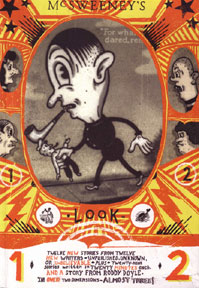 McSweeney's,
#12 McSweeney's,
#12
Theme: Stories from previously
unknown authors.
Editor(s): Dave Eggers
Address: 826 Valencia Street
Valencia, CA 94110
Website: www.mcsweeneys.net
While the website is a headache to navigate,
the literary journal is well built and exciting to look
at. The cover art, reminiscent of Robert Crumb's Artwork
(he is best known for Fritz the Cat as well as other underground
comics during hte 60's and 70's), it reflects the stories
inside. The stories, varying in length from half a page
to forty, are not genre specific and the themes range from
the mundane to the fantastical.
The authors in this volume are all unpublished
and brief bios are in the back of the book. This issue also
has a brief photographic essay about the first Russian Cosmonaut,
Yuri Gargarin.
Regarding the submission
process: When sending a cover letter be brief. Don't
fret if you haven't been published or don't have an MFA,
they aren't really concerned with that. Like all publications
however, make sure you know a bit about McSweeney's so that
you can guage if your work fits their style. McSweeney's
publishes only fiction. However, memoirs are published from
time to time. Length of pieces, "can be as long as you want."
You can send submissions via e-mail to,
printsubmissions@mcsweeneys.net. Make sure you send the file as an MS Word attachment or you can copy/paste the story into the body of the e-mail, but they prefer it as an attachment (read as: it won't be received with nearly as much efficiency). Response time for all submissions can take anywhere from a few weeks to five months.
For more information on submitting to the McSweeney's Quarterly,
website, or other books they publish go to their website.
More information regarding the quarterly can be found at
http://mcsweeneys.net/submit/print.html
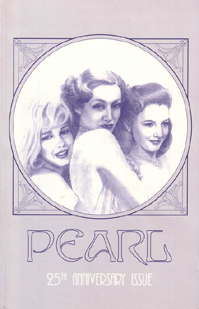 Pearl,
#29 Fall/Winter 2000 Pearl,
#29 Fall/Winter 2000
Theme: 25th Anniversary Issue
Editor(s): Joan Jobe Smith, Marilyn Johnson&
Barbara Hauk
Address: 3030 E. Second Street, Long Beach
CA 90803
Website: www.pearlmag.com
Pearl is an attractive 96-150 page, perfect-bound magazine
featuring poetry, short fiction, and black & white artwork.
Those published range from people who teach at universities
and are well published, to beginners; a nice mix.
This particular issue only contains poetry. The voice/style
is a lusty, electric, eclectic mix. Subject matter ranges
from sex and relationships to pets, movie stars and human
interest–real people, real stuff. Pearl is interesetd
in "accessible, humanistic poetry and
fiction that communicates and is related to real life. Although
we have no taboos stylistically or subject-wise, we are
not interested in sentimental, obscure, predictable, abstract,
or cliché-ridden poetry or fiction." This journal
is not highbrow or stuffy, and the quality of the poetry
is excellent. It has also been around for nearly 30 years.
Regarding submission: Read
the magazine before submitting. You can purchase a sample
copy for $7.00. For poetry send 3-5 previously unpublished
poems with a cover letter and SASE. Fiction writers should
also send previously unpublished stories as well as the
cover letter and SASE. Stories can be short-shorts (up to
1,200 words), or longer stories up to 4,000 words. There
are NO e-mail submissions. Simultaneous submissions must
be acknowledged as such. The reading period is September-May
and you will hear back in 6-8 weeks if your work is accepted
and the piece will appear in 6-12 months from the acceptance
date. Contributors receive a copy of the journal as payment,
and additional copies may be purchased at 50% off.
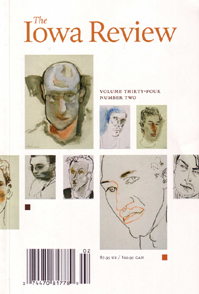 The
Iowa Review, Vol. 34, #2 Fall 2004 The
Iowa Review, Vol. 34, #2 Fall 2004
Theme: --
Editor(s): David Hamilton
Address: 308 EPB University of Iowa Iowa
City, IA 52242
Website: http://www.uiowa.edu/~iareview
The Iowa Review is an attractive professionally printed,
flat-spined book with a color printed cover. The book is
made with high-end, quality paper with both aesthetically
pleasing and readable type. The Review is set in Iowan Old
Style, a typeface designed by John Downer. The current issue
cover features artwork by Joseph Patrick a professor of
painting. The paintings embody humanitarian subject matter
in a stylized and contemporary way.
Profiles of the authors: There appears to be an eclectic mix of voices. Primarily, the authors are established and teach in universities. However, they do accept new talent. This issue features a back issue poem by the late Jane Kenyon, while also featuring Mark Walters' first published short story.
The subject matter ranges from exaltation, with a narrator spending the day at the zoo to another narrator's account of a grim armed robberywhere the bandits wear of allthings, pig masks. Humor plays a part in the Review. However, it is intelligent humor as opposed to slap-stick. There is a great deal of concern with literary traditions and experimentation. The Review has an American flavor, but remains above all formal in style while tackling personal and at times emotional subject matter. without cliché.
In this issues many stories took a humanistic, multi-dimensional approach to looking and expressing languagelife alteringmoments paired with absurdity and family portraits with greater consequences in regard to meaning.
This is one of the better reviews out there. Poetry in many journals looks similar, as if it was born out of the same school, meaning it's boring and repetitive. The Iowa Review contains new material and the poets take risks, but there still needs to be more risktaking on the page (referring to the form or layout of the book).
On submitting to The Iowa Review:
It is really important to read the Review and back issues,
which can be browsed on the website. A sample can be purchased
for $7., and a subscription costs $20. Send 3-6 poems at a time. For stories, poems, essays and reviews: No e-mail submissions. The cover letter must contain the title of the work and genre. SASE is required (as usual). The journal reads unsolicited submissions "only in the Fall semester, September through November, and then contest entries in the spring." They respond in up to 4 months. The time between acceptance and publication is "around a year."
There are no specifications as to form, length, style,
subject matter or purpose. However, poets should keep in
mind, only 40 pages of the 175-192 page review will accomodate
poetry. Payment: Pays $25 a page for the first page and
$!5 fore each subsequent page, 2 contributor's copies and
aone-year subscription. Other; Contest/Award Offerings.
Sponsors the Time McGinnis Award. "The amount of $500 is
given irregularly to authors of work with a light humorous
touch." All submissions are considered for this award.
In 2003 the Iowa award in Poetry, Fiction and Essay was
instituted. The entry fee is $15. Postmark Deadline: February
1, but "submit in January." Outside judges determine the
finalists and winners. The winner receives $1,000 and publication.
About 100 pages are set aside for the finalists and winner
in the December issue.
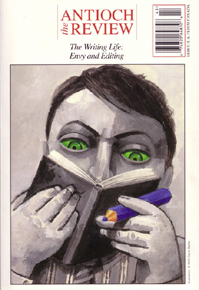 Antioch
Review , Vol. 62, #4 Fall 2004 Antioch
Review , Vol. 62, #4 Fall 2004
Theme: No Theme
Editor(s): Robert S. Fogarty and Judith
Hall (Poetry Editor)
Address: P. O. Box 148, Yellow Springs,
Ohio 45387-0148
Website: www.antioch.edu/review
While the cover art is good there is no art inside. The journal is professional looking but a bit bland. All of the fiction writers and essayists are well-published. Many have a novel or novella or collection of stories published. At the very least they have been published in a few reputable journals. The poets have all published at least a few books of poetry with the exception of one who has been published in several journals
The essays are very intelligent and have a wide range of
topics from writing to Cubans in Tampa to why people either
love or hate Texas. The fiction's theme is family problems.
It isn't predictable and it isn't black and white. There
is really nothing outstanding about the poetry. There are
some nature themes and the poetry is very tangible but simultaneously
not that imaginative.
The essays are the strength of this journal. THe fiction
is noteworthy and the poetry is not outstanding, but the
essays carry the weight. Particularly the essays about the
decline of writing are worth reading.
On submitting to the Antioch Review: The review accepts no e-mail submissions. Send an SASE. The manuscripts should be typed, double-spaced on one side of white, 8.5x11 paper. Spare the editors the task of reading carbons or dirty Xerox copies or pages with excessive inter-linear corrections and revisions. Manuscripts should be mailed flat, fastened by paper clip only, and one at a time (does not apply to poetry). Do not mix prose and poetry in the same envelope. They do not accept simultaneous submissions.
Reading Period: Fiction manuscripts and
Essays are NOT read between June 1st to September
1st. Poetry is not read in the summer (May 1st
to September 1st. Poetry/Essay/Fiction
Length: Submit three to six poems at one time.
Articles and stories should not be over 5,000-and 8,000
at the outside limit.
"The best answer we can give on inquiries relating to what
kind of material the Antioch Review uses is, 'read the magazine.'
Look through a few representative issues for an idea of
subjects, treatment of articles, and stories we have used;
it will be far more rewarding than any theories we might
try to formulate."
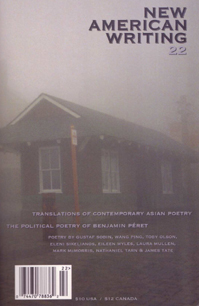 New
American Writing, Vol. 22, 2004 Issue New
American Writing, Vol. 22, 2004 Issue
Theme: Anything that breaks from teh traditional
Editor(s): Fiction editor: Maxine Chernoff,
Poetry editor: Paul Hoover
Address: New American Writing, 369 Molino
Avenue, Mill Valley, CA 94941
Website: www.newamericanwriting.com
New American Writing has a very streamlined, simple
look. The content (the text) is small, simple and the journal
really emphasizes the contrast of white space around text.
The journal doesn't include artwork, except for the cover
art, which can range from collage work, to a painting, to
a photograph. The journal's website emphasizes that it chooses
artwork by leading American artists. The cover art seems
to coordinate with the feature work of the journal as well.
The journal doesn't include any biographical information
on the authors, but some issues have included well known
authors such as Gary Soto, John Ashbery, Robert Creeley,
Charles SImic, Jorie Graham, Denise Levertov, etc. The journal
does not hesitate to publish the work of its own editors
as well. The Asian poets whose work was translated for the
most recent issue are very well known writers within their
own countries and abroad, including Korea's most prolific
and well known living poet, Ko Un.
The journal seeks writing that is experimental in form
and language, and writing that challenges the traditional
conventions of poetry and fiction.
Poetry: The tone of the poems varies within
the journal including more accessible poems such as "Hand
Model," which institutes a playfulness of language. Most
of the poems emphasize (or at least give equal consideration
to) the way language & words move across a page. The meanings
of poems published tend to be more obscure and harder to
grasp, although the words, sounds, and alliterations play
a large role in the overall meaning and construction of
the poems. NAW also publishes prose poems as well. The poems
chosen for translation (both the Asian poets and the French
poet) tend to focus on war, exile, political isolation and
political dissention.
Fiction: The fiction chosen for publication
tends to be short fiction, on a range of topics/subject
matter. IN this issue, the fiction is a series of stories,
written in very short, quick vignettes.
NAW accepts interesting, cutting-edge poetry and fiction
that challenges traditional writing often found in most
other journals. New American Writing seems to serve
as an outlet or a space for non-traditional writers to publish.
Though some of the poetry is enjoyable, some of it does
seem to be highly inaccessible both in meaning and layout.
Nearly every poem and piece of fiction is attempting to
take a risk, whether it is with meaning, language, layout,
or all three. Although not all pieces achieve a unity and
accessibilitiy within their risks, the writing challenges
all notions of what creative writing is and where it is
going. Thus, New American Writing serves as a venue for
non-traditionalists to publish work, and it also serves
as a source to access writing in translation that isn't
always made available to American writers.
Work from NAW has also appeared in the distinguished Pushcar
Anthology. In 1988 the magazine was named one of the nation's
ten outstanding literary magazines by Coordinating
Council of Literary Magazines (now called, Council of Literary
Magazines and Presses (CLMP).
Advice for Submitting: Read,
read, and re-read the type of writing published in NAW,
and check out the website for more information on the journal.
Don't send work that doesn't break a rule. If you ask yourself,
did I just write a poem or a story? Is this really a poem/story?,
then send the piece. if it's traditional, send it to another
journal.
For poetry, send no more than five poems in each submission.
Fiction stories should not exceed 30 pages in length. There
are no specific length requirements for poetry, but from
reviewing the journal they generally don't publish work
that would take up more than 2 pages. Fiction should not
exceed 30 pages, but based on the length of fiction that
has been recently published, the editors prefer short-short
stories.
Response time varies between 2 weeks and 6 months. The
journal does not accept e-mail submissions. Neither the
journal nor the website mentioned wether or not it accepts
simultaneous submissions. However, it will re-print work
that has appeared in other publications. The reading period
is from June to January.
|